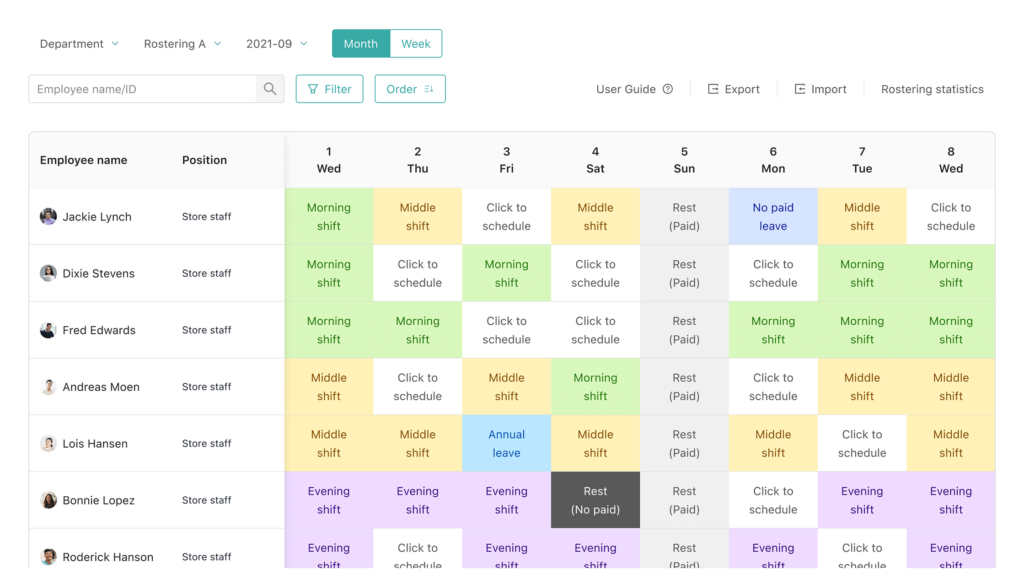Employee rostering may frequently feel too many company organizations like a jigsaw that never quite fits together neatly. It may be very difficult to balance workloads, manage shifts, and handle last-minute adjustments. These difficulties frequently result in ineffective operations, increased labor expenses, as well as irate staff members.
However, effective human resources systems for staff rostering have the power to completely change the way your company runs. It may also lower expenses, increase output, and raise worker satisfaction.
In this blog, we’ll look at how effective staff rostering may revolutionize your company’s efficiency and offer doable solutions to help you get there.
What Is Employee Rostering?
At its core, employee rostering is about assigning the right people to the right shifts. But it’s not just about filling slots on a schedule; it’s about ensuring that your business has the right number of employees at the right times to meet demand.
A good rostering system takes into account factors like employee availability, skills, and preferences. It also ensures that your business operates efficiently.
Rostering isn’t a one-size-fits-all process. Every business has different needs, whether it’s managing rotating shifts in a retail environment or ensuring adequate coverage in a healthcare setting. The goal, however, remains the same: balancing business needs with employee well-being.
Why Efficient Employee Rostering Matters?
Efficient rostering can have a profound impact on your business. Here’s why it’s essential:
- Increases Productivity: By ensuring that your business is neither overstaffed nor understaffed, efficient rostering optimizes productivity. Employees are working when they’re needed most, reducing idle time and maximizing output.
- Enhances Employee Morale: Fair and transparent rostering processes can improve employee satisfaction. Therefore, when employees feel that their time is respected and their shifts are distributed fairly, they’re more likely to be engaged and motivated.
- Reduces Costs: Proper scheduling prevents excessive overtime and minimizes labor costs. Hence, aligning staffing levels with actual business needs helps eliminate unnecessary expenses. That’s the utilization of the best HR system software for your organization.
- Ensures Compliance: Adhering to labor laws and regulations is easier with a well-structured rostering system. You can avoid costly violations by ensuring employees are scheduled in line with legal requirements.
- Supports Business Scalability: As your business grows, a solid rostering system becomes even more critical. Moreover, efficient rostering provides the flexibility needed to scale operations without losing efficiency.

What Are The Challenger in Employee Rostering?
The benefits of efficient rostering are clear, it’s not without its challenges. Some common hurdles include:
- Conflicting Availability: Employees often have different availabilities due to personal commitments. Thus, it makes it difficult to create a consistent schedule.
- Skill Variability: Not all employees have the same skill sets, and allocating the right people to the right tasks can be tricky, especially in specialized industries.
- Demand Forecasting: Sometimes, predicting business demand accurately becomes essential. Though, errors can happen and those can lead to overstaffing or understaffing, both of which hurt productivity. Hence, your organization requires human resources systems to properly maintain a balanced employee strength.
- Employee Preferences: Balancing the needs of the business with employee preferences can be a delicate act. Ignoring employee preferences can lead to dissatisfaction and burnout, but catering too much to preferences can impact business operations.
- Last-Minute Changes: Emergencies happen, and sudden changes in staffing can disrupt even the best-laid plans.
- Transition to Technology: There are many businesses that still rely on manual rostering processes. These are time-consuming and prone to errors. On the other hand, transitioning to automated systems can be daunting but is crucial for long-term efficiency.
Steps to Improve Employee Rostering
Improving your employee rostering process doesn’t have to be an overwhelming task. Here are some practical steps to make your rostering more efficient:
Forecast Demand Using Data
One of the keys to efficient rostering is accurate demand forecasting.
So, look at historical data, seasonal trends, and current business needs to predict peak times and adjust staffing levels accordingly. Implementing data analytics tools can help your business make more informed scheduling decisions.
Consequently, these will lead to fewer errors and better resource allocation.
Automating your scheduling process can be helpful. Scheduling software can help reduce the time spent on creating rosters, minimize errors, and ensure compliance with labor laws. Automated HR system software also offers features like shift swapping and real-time updates.
These things make it easier for authorities to manage last-minute changes without causing disruptions in their operations.
Prioritize Employee Preferences
While business needs come first, taking employee preferences into account can improve morale and reduce turnover. Consider offering flexibility with shift swaps and using self-scheduling software where employees can have some control over their shifts. Engaged and satisfied employees are more productive, and a happy workforce ultimately benefits your bottom line.
Regularly Review & Adjust Rosters
Rostering isn’t a set-it-and-forget-it process. Regularly reviewing and adjusting your rosters based on real-time business data and feedback from employees will help you maintain efficiency. This flexibility allows your business to adapt quickly to changes, ensuring that you’re always operating at peak productivity.
Cross-training your employees can help you create a more flexible roster. When employees can perform multiple roles, it’s easier to fill gaps and ensure that your business is always adequately staffed, even during unexpected absences or peak times.
Hence, this approach also helps employees feel more valued and engaged, as they acquire new skills and experiences. So, if you want to incorporate human resources systems in your management, contact YOOV.

The Role of Communication in Rostering
Effective communication is a critical component of successful rostering. When employees are kept in the loop and understand the rationale behind scheduling decisions, it fosters a culture of trust and transparency.
Hence, open communication channels allow employees to voice their concerns, request time off, or swap shifts easily. When communication is clear and timely, everyone stays on the same page, which reduces misunderstandings and increases overall efficiency.
Here’s how to improve communication within your rostering process:
- Use Scheduling Software with Communication Features: Many scheduling platforms include built-in messaging systems that allow employees to communicate directly with managers or each other. This feature helps resolve issues quickly and keeps everyone informed.
- Hold Regular Meetings: Regular check-ins with employees to discuss scheduling needs, upcoming events, or potential changes can help keep everyone aligned. Thus, these meetings also provide an opportunity for employees to raise any concerns or suggest improvements.
- Provide Accessible Rosters: Ensure that rosters are easily accessible to all employees, whether through a mobile app, email, or a physical notice board. The more accessible your roster is, the fewer misunderstandings and missed shifts you’ll encounter.
The Impact of Efficient Rostering on Employee Wel-Being
Employee well-being is increasingly recognized as a critical factor in business success. Efficient rostering can play a significant role in supporting employee health and happiness. So, implement HR system software in your business management.
Therefore, by providing a balanced and fair schedule, businesses can reduce stress and prevent burnout. So, it leads to a more productive and engaged workforce.
Here are some ways efficient rostering can support employee well-being:
- Work-Life Balance: A fair roster that considers employee availability and personal needs helps employees maintain a healthy work-life balance. This balance leads to happier employees who are more committed and less likely to experience burnout.
- Reduced Overtime: Excessive overtime can lead to exhaustion and decreased productivity. Efficient rostering minimizes the need for overtime by ensuring that the right number of employees are scheduled for each shift.
- Predictable Schedules: Predictable scheduling allows employees to plan their personal lives more effectively. When employees know their schedules well in advance, they can make plans without the stress of last-minute changes.
End Note
Efficient employee rostering isn’t just about getting people on the floor. Human resources systems could be a strategic advantage that can drive productivity, reduce costs, and improve employee satisfaction.
Therefore, if your business organization can forecast employee demand accurately, you can properly optimize resources. Ultimately, efficient rostering helps businesses operate smoothly, employees thrive, and customers receive the service they expect.
Connect with YOOV

Tel:+852 2988 8883
WhatsApp:Click Here
Email:cs@yoov.com
Website:https://www.yoov.com/